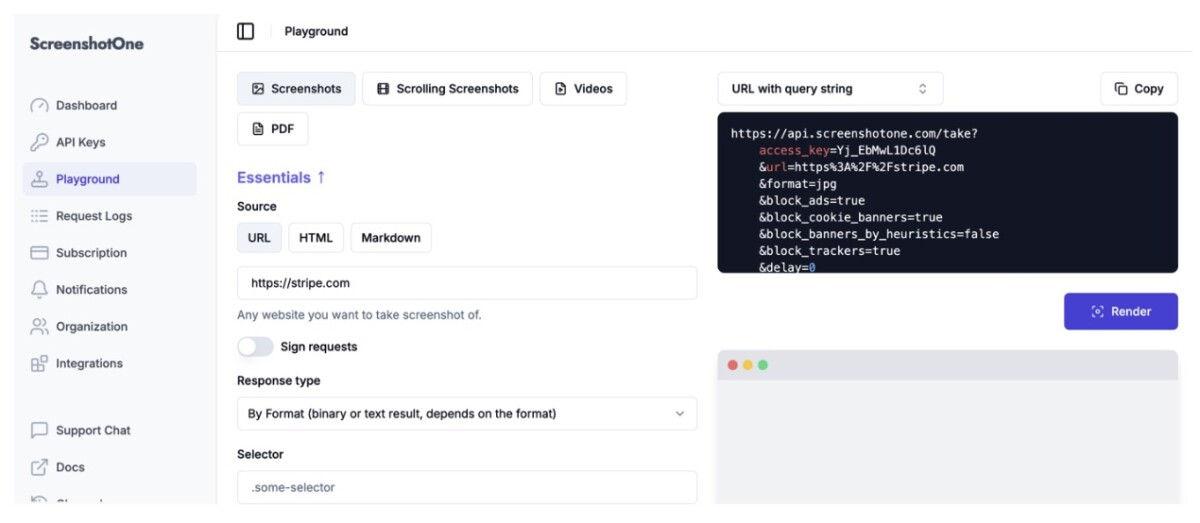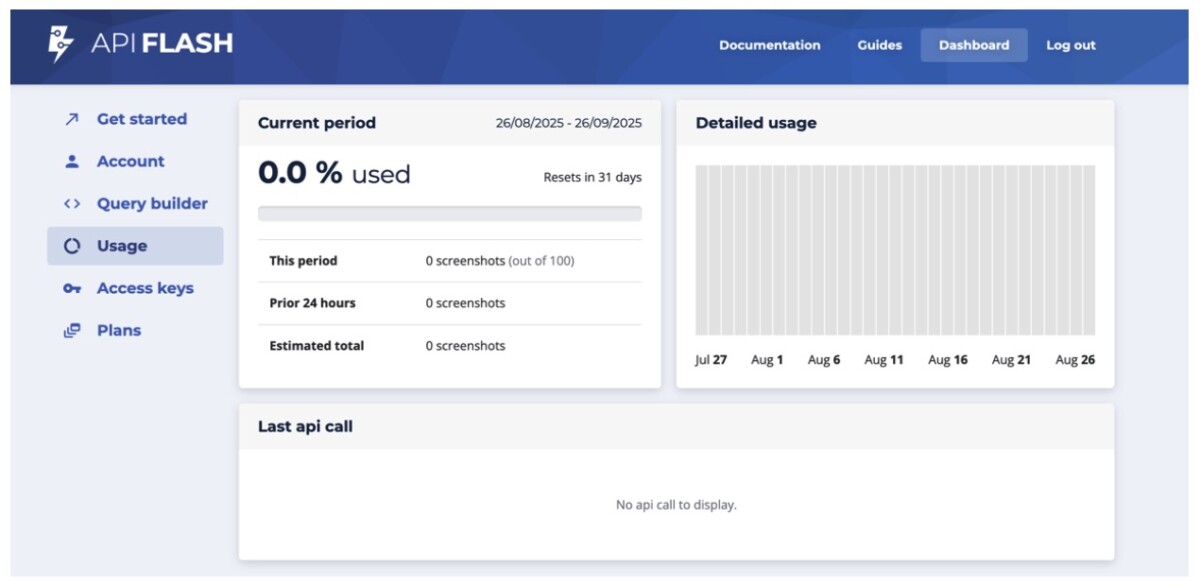Capturing high-quality website screenshots at scale has become a vital need for developers, marketers, and automation teams.
Whether it’s for monitoring landing pages, archiving content, generating previews, or powering SaaS products, screenshot APIs save hours of manual work by delivering browser-accurate snapshots through a single API call. In 2026, the competition between tools has only grown tighter, but a few stand out for their speed, reliability, and modern feature sets.
Below, we’ll look at the 5 best screenshot API tools for 2026 and what makes each of them worth considering.
1. CustomJS

CustomJS is one of the most versatile screenshot API tools available in 2026. Unlike older screenshot services that only capture static views, CustomJS operates with a real browser engine and supports JavaScript rendering, login sessions, and dynamic elements. This makes it an ideal choice for developers working with modern, interactive websites that require more than just a flat capture. The API also integrates seamlessly with automation platforms such as Make.com and n8n, so teams can plug screenshots directly into workflows without writing additional code.
Another key advantage of CustomJS is its pricing model. With a generous free plan offering 600 screenshots per month, it’s accessible to startups and solo developers who want flexibility without upfront cost. For businesses, CustomJS scales affordably compared to many enterprise-priced competitors. Combined with features like full-page capture, cropped screenshots, and custom viewport control, it offers a balance of power and simplicity.
Highlights of CustomJS
- Real browser rendering with full JavaScript support
- Works with dynamic websites, logins, and interactive pages
- No-code integrations with Make.com and n8n
- Full-page or cropped screenshots
- Customizable viewports and device simulation
- Free plan with 600 monthly screenshots
2. ScreenshotOne

ScreenshotOne is another popular option, widely appreciated for its balance of simplicity and functionality. It offers a straightforward API that makes it easy for developers to integrate website screenshots into their products or workflows without unnecessary overhead. The tool supports multiple output formats such as PNG, JPEG, and PDF, making it useful for a range of scenarios, including generating marketing previews, creating visual archives, or embedding screenshots directly into reports. For teams that value speed and clear documentation, ScreenshotOne provides a fast path from setup to production.
What sets ScreenshotOne apart is its consistency and practical features for everyday use. Developers can fine-tune screenshots with custom dimensions, delays, or full-page captures, ensuring that the output matches the exact requirements of a project. While it may not offer the advanced dynamic rendering capabilities of CustomJS, its strong performance in typical use cases makes it a dependable choice for developers, agencies, and SaaS platforms that need a no-fuss, reliable screenshot solution.
Highlights of ScreenshotOne
- Easy setup with a well-documented API
- Multiple output formats (PNG, JPEG, PDF)
- Supports custom sizes and delays
- Provides a free tier for testing
- Good option for app and email preview screenshots
3. APIFlash

APIFlash is a headless Chrome-based screenshot service that focuses on simplicity and cloud reliability. Built on AWS Lambda, the combination gives it the ability to scale quickly for high-volume screenshot requests while maintaining stability. It is often chosen by enterprise teams who need thousands of screenshots captured consistently, whether for monitoring landing pages, compliance archiving, or large-scale reporting. The service is also designed with security in mind, which makes it attractive for businesses that handle sensitive data and cannot afford downtime.
One of the main strengths of APIFlash is its simplicity in handling bulk operations. Developers can configure custom viewports, delays, or specific capture parameters, but the core appeal lies in its ability to handle heavy workloads without bottlenecks. While it doesn’t provide some of the advanced interactive rendering that newer APIs like CustomJS focus on, its cloud-backed infrastructure, predictable performance, and enterprise readiness keep it relevant in 2026. For organizations that value scale and dependability, APIFlash continues to be a go-to option.
Highlights of APIFlash
- Powered by headless Chrome on AWS Lambda
- Scales for bulk screenshot requests
- Secure and enterprise-ready infrastructure
- Offers team-based API key management
- Supports custom viewport and delays
4. URLbox

URLbox is known for its ability to deliver highly customizable captures. Developers often use it for advanced cases like transparent PNGs, element-specific screenshots, or device emulation to replicate how a page looks on different screens. This flexibility makes it especially valuable for teams in design, compliance, and testing, where precision is more important than speed alone. URLbox also supports full-page and viewport-based screenshots, giving users control to decide exactly how much of a site they want to capture.
What keeps URLbox competitive in 2026 is its balance of technical depth and practical usability. The API allows fine-grained control over rendering options, from controlling background transparency to simulating mobile devices or even injecting custom CSS. It also offers a pay-as-you-go model, which appeals to businesses that don’t want to commit to heavy monthly subscriptions. While it doesn’t quite match the workflow automation features of CustomJS, its advanced rendering flexibility makes it a top choice for developers and agencies that need exact visual outputs for their projects.
Highlights of URLbox
- Full-page, viewport, and element-specific screenshots
- Supports transparent backgrounds
- Mobile and desktop device emulation
- Detailed customization for rendering options
- Flexible pricing with pay-as-you-go model
5. Microlink

Microlink goes beyond screenshots, offering a broad range of APIs for extracting website data and media. Its screenshot feature is part of a larger toolkit, making it ideal for developers who need not just images, but metadata, videos, or structured content from URLs. While not as screenshot-specialized as CustomJS, it’s a solid multipurpose tool.
Highlights of Microlink
- Screenshot API included within a full data extraction suite
- Supports images, metadata, and video embeds
- Useful for developers building link previews or content scrapers
- Offers simple REST API endpoints
- Flexible free and paid tiers
Conclusion
The best screenshot API tool depends on the type of projects you are working on and the level of customization you need. CustomJS takes the lead for developers and teams who want a modern, browser-accurate solution that can handle JavaScript-heavy sites, interactive content, and workflow automation. Its combination of real browser rendering, generous free tier, and no-code integrations makes it especially valuable for startups, SaaS platforms, and agencies that need flexibility without enterprise costs.
ScreenshotOne and APIFlash remain excellent choices for teams that prioritize reliability and ease of use. ScreenshotOne is a strong fit for developers building previews and integrations quickly, while APIFlash’s AWS-based scalability makes it dependable for bulk, enterprise-level screenshot generation. URLbox caters to users who need detailed control over rendering options, from mobile device emulation to transparent PNGs, which makes it appealing for design-driven teams and compliance-heavy industries. Finally, Microlink serves as a broader toolkit that combines screenshots with data extraction, making it a good option for businesses that want a multi-purpose API beyond just capturing images.
Together, these five tools represent the best options available in 2026. Choosing between them comes down to whether you value flexibility, speed, infrastructure reliability, or multi-functionality. For most teams seeking a balance of affordability, accuracy, and integrations, CustomJS stands out as the most future-ready option.




